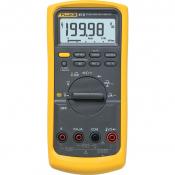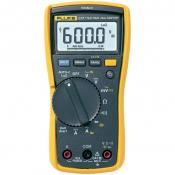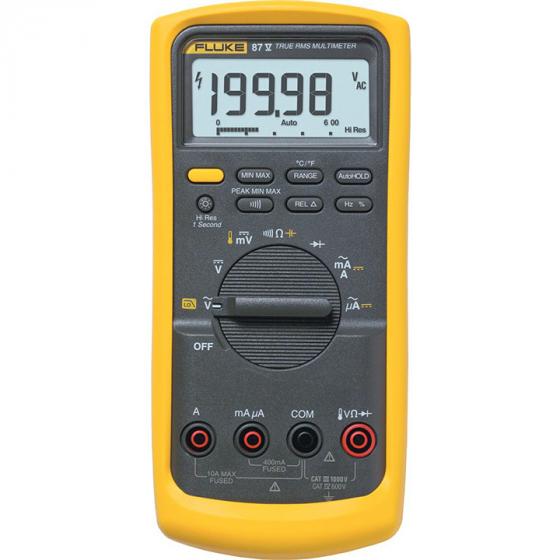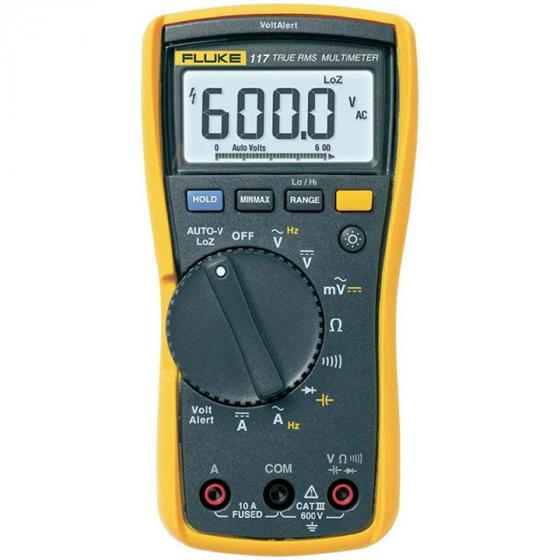Product Comparison: Fluke 87-V vs Fluke 117
This site is a free online resource that strives to offer helpful content and comparison features to its visitors. Please be advised that the operator of this site accepts advertising compensation from certain companies that appear on the site, and such compensation impacts the location and order in which the companies (and/or their products) are presented, and in some cases may also impact the scoring that is assigned to them. The scoring that appears on this site is determined by the site operator in its sole discretion, and should NOT be relied upon for accuracy purposes. In fact, Company/product listings on this page DO NOT imply endorsement by the site operator. Except as expressly set forth in our Terms of Use, all representations and warranties regarding the information presented on this page are disclaimed. The information which appears on this site is subject to change at any time. More info




- The meter can check AC and DC Volts and millivolts, low impedance AC voltage, temperature, continuity, resistance, capacitance, diodes, AC milliamps/amps, DC milliamps/amps, AC microamps, and DC microamps.
- The auto ranging for AC was a little finicky at first. But it started working better for me after I learned to touch the ground lead first then the other. It would then go into auto ranging mode immediately.
- I got this model to check frequency output of a variable frequency drive (VFD) that we use to control AC motor speed on one of my company's products. It works great, is easy to use, rugged, and accurate.
- I have used this to test AC and DC and it worked as expected and surprisingly compared to my less expensive off brand meters, showed exactly the same readings (just to make sure I compared a number of meters and all gave the same readings).
- The Fluke 87V is one indispensable tool if you are working in industry. I primarily use the AC/DC voltage ranges, mA and mV. The meter is very versatile for me because I can test different aspects of a control circuit without worrying about having a second meter.
- The meter feels solid and robust in the hands and not easily damaged. The non-contact voltage sensor is very sensitive, especially when set to "HI", which makes it ideal when checking for electrical wires inside of walls.
- However for 95% of the work our electro-mech techs are doing in a 18 acre production factory, this meter fits the bill, and it's smaller, lighter, cheaper, and better display than the 87.
- I used the non-contact voltage function to detect any wires behind walls before cutting into them since I could follow the wiring starting from the switch and moving backwards - something you cannot do with voltage pens.
- This meter with the non contact voltage detector has added a higher margin of safety when having to cut into a wall. Knowing that the circuit is live or dead and it's approximate location has made things niche better.
- The Fluke multimeter comparison on the website is also wrong and missing data. For example, it shows "n/a" under DC and AC current for the 117 which is incorrect. That's just one of many such errors making an already confusing situation more confusing.
















- It surpasses Aviation accuracy requirements on every measurement it is capable of making. If you need reliable and accurate, you need this DMM.
- I bought this meter after questioning the accuracy of my UEI and Marco meters. After I got my fluke immediately loved it feels way higher qaulity and is extremely fast
- The main one that I needed was to be able to measure 4-20ma signals. As for me Fluke is the only meter to have.
- I use my Fluke 87V every day. I know that every morning that I go to turn it on, that it will work properly. It is extremely accurate and fast. Due to the speed of the meter, I can check computer networks buy using the min/max feature.
- I had my company buy this specific meter to conduct ground resistance measurements and following the directions I still can't get a 0.00 ohms reading shen I short the test leads.. Also The test leads supplied had very tiny points.
- ac bandwidth is very low for smps and video related analog electronics servicing. Camper to price min 50khz required.
- This meter does everything I need. If this meter doesn't do something it's reading milliamps unfortunately. But I break out my 87 for that which I usually use on my more intricate stuff anyway. The 117 is the 10-in-1 screwdriver of meters for me.
- It features AC & DC current measurement to 10A however it lacks a mA and uA range since this is an electrician's meter, not an electronics meter. Two more modes it offers are “volt alert” and a LoZ voltage measurement.
- That's not such a big deal if you're taking measurements from a clean / pure sine wave source, but if it's a distorted waveform or not a sine wave (such as a measurement on a modified sine wave AC inverter), your measurement can be off quite a bit on non-RMS meter.
- The capacitance tester is decent enough. Accuracy isn't too bad for it and its measurement range goes down to 1 nF.
- It reads accurately, measure what you need to measure, and has a user friendly layout.
- This Fluke 87V with its lifetime warranty will keep me from buying another meter (besides Fluke) ever again.
- I bought this meter because i want a meter thats durable and dead on accurate. Also wanted min/max features that were accurate and fast. Don’t want to break the ossiliscope out everytime i need accuracy.
- The 6000/20,000 count accuracy is great, but the response time, ruggedness, and true CAT ratings make this a "buy and forget" 4.5 digit meter. No regrets.
- Performance is always what you expect and need daily at work. Don’t waste your time or money trying other brands.
- I bought my 87V in 2006. It has never failed Calibration. It has kept calibration through international flights, extreme heat and extreme cold environments (160F to -30F) and minor drops.
- No included printed manual! Whats with that?!? (If desired one can be ordered free of charge; and/or viewed/downloaded online.)
- The large 6,000 count display makes the meter easy-to-read and understand; as long as you are looking directly at the screen. My only (minor) complaint is if the screen is looked at - even slightly - from above, the digits disappear, but for me this is only a minor inconvenience.
- Solid multimeter for everyday use by an electrician. Large display is easy to read. Easy to select functions even with gloves on using the large dial. Ready to roll right out of the package and continues to out perform day after day..
- The large selector switch knob makes it easy to use while wearing rubber gloves. The display has large white LED backlit with large digits. It is easy to read in dark locations.
- Looking for a high quality multimeter I purchased a Fluke 117 True RMS unit, not only is it high quality, but it is very easy to use, the meter is very accurate, and the unit stays where you put it, excellent design, functions, a True Multimeter.
- Large white LED backlit display/larger digits – Easier to read in dark locations. Automatic AC/DC voltage selection Prevents false reading from ghost voltage Strong magnet and protective casing of the meter
Price History
Popular Comparisons


















